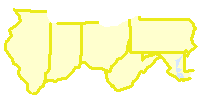
Home
In the
Beginning
Related
Links

National Old Trails Road & US-40
It was really technology that brought the growth of the National Road to an end. Canal boats and rail cars were taking over from the Conestoga wagons. Canals preceded railroads in this country by a few years but they launched their challenge to the National Road simultaneously. The Fourth of July has been a big holiday since that first Independence Day anniversary in 1777. It's a pretty good day for starting things and has seen quite a few ship keels and cornerstones put in place. In 1825, in Ohio, it saw ground broken for both the Ohio & Erie Canal and the National Road. Just three years later, on July 4, 1828 ground was broken for the C & O Canal and the first stone was laid for the B & O Railroad. While canals, including the Ohio & Erie, were highly successful elsewhere, the C & O was defeated by geography. Not so the B & O.
Railroads took the transportation lead and held it into the twentieth century. Then something came along that, at least for some purposes, was even better. That was the automobile and as its reliability and range increased, so did its popularity. Soon lots of people were traveling by car and looking for roads to drive on. Once again there was talk of a road across the nation but the nation was a whole lot wider now.
There was, in fact, talk of several roads across the nation. There was the Lincoln Highway and the Yellowstone Trail. The Old Spanish Trail and the Pikes Peak Ocean to Ocean Highway. And then there was the National Old Trails Road. Sorting out all that was involved in getting the NOTR together is just too much for me. It started with something called the Missouri Cross State Highway, had the Daughters of the American Revolution as major boosters, and had about half a dozen proposed end points. There were plenty of practical considerations in picking the route but there was also a certain amount of history and romance in stitching together a series of old trails to cross the entire country. One of those "trails" was the old National Road finding new life as the Cumberland, MD, to St. Louis, MO, section of the NOTR. Others were Braddock's Road, Boones Lick Road, the Old Santa Fe Trail, and the Grand Canyon Route.
The heyday of named highways was not long. The Lincoln Highway, born in 1913, is considered the first of the coast to coast routes and, even though some supporting organizations still existed at the end of the 20s, the named highways were effectively finished when a system of numbered US highways was adopted in 1926. If boring numbers were going to replace catchy names, proponents of the named highways at least wanted their routes to remain intact and be designated by a single number. But none of the major ocean to ocean highways made it into the grid of US highways entirely in one piece. The Old Spanish Trail was, for the most part, split between US-80 and US-90 and the Lincoln Highway, even though it went a long way as US-30, it reached the Pacific as US-50. US-20 replaced most, but not all, of the Yellowstone Trail. The Pikes Peak Ocean to Ocean Highway, sometimes referred to as "the highway that couldn't make up its mind" even when the named trails were going strong, became all but lost in the switch to numbers. The National Old Trails Road, created by stitching together a collection of existing roads and trails, became unstitched. In the east, much of the NOTR, including the original Cumberland Road, became US-40. In the west, the new designation was US-66.